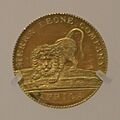Sierra Leone Company facts for kids
The Sierra Leone Company was a special company that helped create the second British colony in Africa. This happened on March 11, 1792, when they helped Black Loyalists settle in a new place called Freetown. These Black Loyalists were formerly enslaved people who had fought for the British during the American Revolutionary War. After the war, they first settled in Nova Scotia before moving to Africa.
This company was started by people who strongly believed in ending slavery. Some of the most important people were Granville Sharp, Thomas Clarkson, Henry Thornton, and Thomas's brother, John Clarkson. John Clarkson is even seen as one of the main founders of Sierra Leone. The Sierra Leone Company took over from an earlier group called the St. George Bay Company, which had started in 1790.
Contents
The First Try: St. George's Bay Company
Before the Sierra Leone Company, there was the St. George's Bay Company, started in 1790. This came after an earlier attempt in 1787 by a group called the Committee for the Relief of the Black Poor. They wanted to create a free settlement for poor Black people in London. Many of these people were Black Loyalists who had escaped slavery and fought for the British during the American Revolutionary War.
The 1787 group included about 300 Black people from London, 60 working-class English women, and some white officials and craftspeople. In total, there were 411 men, women, and children. They landed and built their first settlement, calling it Granville Town.
This first colony didn't last long, only about two and a half years. Many people got sick, and some left. The final blow came in 1789 when the local Temne people burned the settlement. This happened because of a fight between the Temne and slave traders. Even though Granville Town was rebuilt in 1791, it wasn't the main starting point for the colony that the Sierra Leone Company created in 1792.
Who Helped Make It Happen?
Both the St. George's Bay Company and the Sierra Leone Company were strongly supported by Granville Sharp. He was a famous activist who fought against slavery. In 1790, he wrote a plan for the new company called Free English Territory in AFRICA.
This plan clearly showed that the company wanted to end slavery. It said that people who invested in the company weren't looking to make money right away. Instead, they wanted to help others and believed it would be good for their country's businesses in the future.
Many early supporters of the company were friends of Granville Sharp. They were part of a group called the Clapham Sect. This group included important people like Henry Thornton, William Wilberforce, Rev. Thomas Clarkson, Rev. Thomas Gisbourne, and Samuel Whitbread.
Facing Challenges to Help Others
At first, the company tried to get a special permission from the king, called a royal charter. But this didn't work because the attorney general, Archibald Macdonald, was against it. So, the company tried to get permission through a special law passed by Parliament.
This also faced opposition. Groups like the Committee of the Company of Merchants Trading to Africa and slave traders in London, Liverpool, Bristol, and Lancaster all spoke out against it. The Standing Committee of West India Planters and Merchants also tried to stop it. They even met with the Prime Minister, William Pitt.
Despite all this opposition, Henry Thornton successfully guided the Sierra Leone settlement bill through Parliament. Even a Member of Parliament (MP) from Liverpool, Bamber Gascoyne, and other people who supported slavery tried to stop it. But on May 30, 1791, the bill passed with 87 votes for it and only 9 against.
Building Freetown: A Home for Freedom
In 1792, John Clarkson led more than 1,100 Black settlers from Halifax, Nova Scotia, to start a new colony. These settlers were mostly formerly enslaved people from the American colonies. The British had freed them during the American Revolution, and they had to move after the British lost the war.
It was the strong will of these settlers that helped Freetown, Sierra Leone, grow and survive after they founded it in March 1792. The Company even made its own money, using dollars and cents. These coins were made in 1791 and 1796.
Life in Early Freetown
When a war started between Great Britain and France (part of the French Revolutionary Wars), the Sierra Leone Company lost supplies and many ships. French privateers (ships that attacked other ships for profit) and the French navy captured them. American merchants, who were neutral in the war, used this chance to trade with the colony.
Trouble continued for Freetown. In September 1794, the French attacked and burned Freetown. But the colonists rebuilt their town, and American merchants helped by selling the company important supplies.
Welcoming More Settlers
During these years, the colony's acting governor, Zachary Macaulay, and his team agreed to let more Black Americans settle in Freetown. They offered free land in Sierra Leone if the new settlers met four rules:
- They needed letters from their religious leaders saying they were good people.
- They had to agree to become British subjects and follow British law.
- They had to pay for their own trip to the colony.
- They had to clear at least one-third of their land for farming within two years of arriving.
The Sierra Leone Company was later replaced by a group called the African Institution in 1807.
Images for kids


